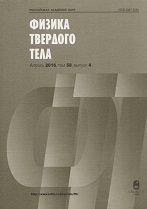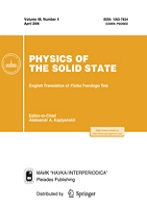|
Liquid crystals
Hydrodynamic mechanism of temperature gradient formation in thin nematic films
A. V. Zakharov
Institute of Problems of Mechanical Engineering, Russian Academy of Sciences, St. Petersburg
Abstract:
The temperature gradient formation mechanism in an initially uniformly heated hybrid-oriented liquid-crystal (HOLC) channel of microscopic sizes upon exposure to a steady hydrodynamic flow is theoretically studied within the nonlinear generalization of the Ericksen–Leslie theory, taking into account the heat conduction equation. The case of total thermal insulation of one of the HOLC channel is considered provided that a constant temperature is maintained on the other surface. It is shown that the temperature difference χmax(ζ) in the HOLC channel section, caused by the horizontal steady flow with the “triangular” velocity profile u(z,ζ) is significantly affected by the position ζ of the maximum velocity. It is shown that, in the case of the LC system formed by 4-n-pentyl-n′-cyanobiphenyl molecules, the hydrodynamic flow characterized by the peak position ζ = 0.98 of the velocity u(z,ζ = 0.98) ∼ 0.9 μm/s forms a maximum temperature difference χmax(ζ) = 0.03 (∼9 K) over the HOLC channel section.
Received: 19.12.2016
Citation:
A. V. Zakharov, “Hydrodynamic mechanism of temperature gradient formation in thin nematic films”, Fizika Tverdogo Tela, 59:7 (2017), 1426–1431; Phys. Solid State, 59:7 (2017), 1454–1459
Linking options:
https://www.mathnet.ru/eng/ftt9537 https://www.mathnet.ru/eng/ftt/v59/i7/p1426
|


| Statistics & downloads: |
| Abstract page: | 52 | | Full-text PDF : | 18 |
|





 Contact us:
Contact us: Terms of Use
Terms of Use
 Registration to the website
Registration to the website Logotypes
Logotypes









 Citation in format
Citation in format 